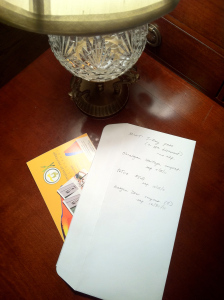A recent Facebook post with a link to The 10 Commandments of Hanging, (see below) according to Melanie Charlton of Clos-ette, drew my immediate attention. I have a duty to my clients to monitor widely-distributed organizing advice for accuracy so I carefully studied each of Ms. Charlton's "commandments." I'm pleased to report that she and I are in absolute agreement upon all but one of these. Take a look at #9:
"Thou shalt color-code. Organizing your clothes by color allows you to visualize an outfit by separates and helps you to mix and match combinations you might otherwise miss."
Color-coding works for some people. Artists and others who are very visual tend to enjoy and thrive off of this system and I'm happy to apply it in those cases. That said, I do not personally believe that organizing clothing by color usually makes sense. I prefer to separate tops, pants, skirts, dresses and other items by season, style, texture or function. For instance, I wouldn't put two tops together simply because they're in the same color family. When I'm dressing, color is the last consideration after sleeve-length and weight, as well as level of formality. Sifting through red cotton t-shirts is a waste of time when I'm preparing for a business lunch.
My recommendation, once you've categorized tops, pants, skirts and dresses is to separate winter/fall items from spring/summer items. If you don't have a large closet, consider storing off-season clothing in a guest closet. Now, divide work pants from weekend pants, evening dresses from sundresses, etc. Next, order according to sleeve/pant length. If you've done all of this and you still have enough clothing in each section to order by color, be my guest, However, this is probably an indication that you have too many clothes! Choose your favorites and donate the rest.
______
The 10 Commandments of Hanging, according to Melanie Charlton of Clos-ette
-Thou shalt hang as much as possible in thy closet. Hang as much as you can with skinny hangers.
-Thou shalt not hang sweaters. Sweaters are best folded and stored on shelves or in drawers to maintain their shape.
-Thou shalt banish wire hangers from thy closet. They are weak, leave marks, and force your clothes to lose shape. Enough said?
-Thou shalt have matching hangers. A hodgepodge of hangers makes your closet look sloppy and prevents clothes from hanging properly.
-Thou shalt use appropriate hangers for appropriate garments. Coats on coat hangers keeps your topper in tip-top shape.
-Thou shalt not kill clothes with plastic. Those dry-cleaning bags are plastic traps for moisture, which can lead to mildew and mold growth, which can severely damage, discolor, and stain. Natural fibers like cotton, wool, silk, and linen need to breathe. Once you bring your duds home, free them!
-Honor the breathing room of thy clothing. Yes, you should hang as much as possible but you should also leave enough space between each garment so they’re not crammed together in your closet. Cramming causes wrinkling and makes you look like you slept in your best suit.
-Thou shalt not hang thy clothes with strangers. Put like with like and hang items facing in the same direction.
-Thou shalt color-code. Organizing your clothes by color allows you to visualize an outfit by separates and helps you to mix and match combinations you might otherwise miss.
-Honor thy pants and sweaters. Keep pants looking freshly pressed by hanging them along their creases or pleats to keep them sharp; always fold sweaters so that they don’t lose their shape.


























